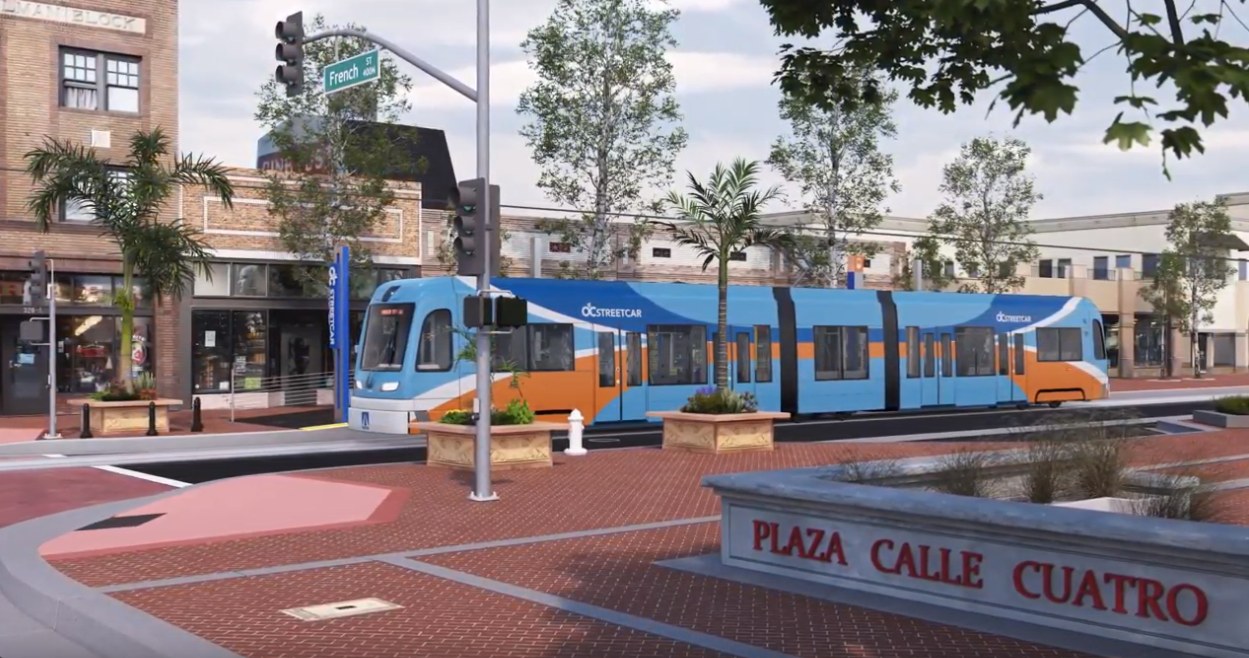
Although California High-Speed Rail is unlikely to ever reach Anaheim’s overbuilt ARTIC station, Orange County nonetheless has its own rail boondoggle: the OC Streetcar. Like high-speed rail, the streetcar is behind schedule, overbudget, and unlikely to provide the benefits project sponsors promised.
When first presented to the federal government, the 4.15-mile streetcar line was expected to cost $289 million. The latest cost estimate of $579 million may still be revised upward now that the Orange County Transportation Authority has further extended contracts with two of its engineering consulting firms.
The project was originally expected to finish in 2021, but that was pushed back to 2024 and now to late 2025. According to an OCTA spokesperson, “identifying the location of old utilities in city streets, contaminated soil and the discovery of Native American remains” contributed to the delays.
Although construction is 85 percent complete and the track has been fully laid, testing has yet to begin. Experience with previous transit projects around the U.S. shows that problems identified during testing can take years to resolve, so, even today, the inception of revenue service next year is still not a sure thing.
Litigation between OCTA and its prime contractor for the streetcar project, Walsh Construction Company, also raises questions about final costs and completion time. As the Register reported in March 2022, Walsh alleged that “OCTA didn’t provide finished or adequate plans and specifications for the project.”
The case continues with Walsh Construction filing a new motion earlier this month and a jury trial scheduled for next February. Meanwhile, Walsh Construction continues to work on the project despite its “quality issues, limited deployment of labor resources, and inaccurate schedule reporting” as alleged by OCTA staff.
Whenever the project finally goes into service, it is unlikely to carry the 7,300 daily riders OCTA projected when seeking federal funding. As with most ambitious transit projects, the initial ridership estimate was likely optimistic, but, in any event, post-pandemic travel pattern changes will have an effect as well.
The OC Streetcar terminates in Santa Ana at the city’s Metrolink station, and commuters using Metrolink can be expected to supply a large proportion of the Streetcar’s riders. But, as with most systems, Metrolink suffered a steep ridership loss during COVID from which it has only partially recovered. Average weekday ridership on the regional system fell from 37,652 in the December quarter of 2018 to just 22,693 in the December quarter of 2023.
As a result, the OC Streetcar is likely to provide far more capacity than needed. Although each train can accommodate up to 211 passengers, a small fraction of this number can be expected to be on board at any given time.
Because trains will only run once every 10-15 minutes and the 4.15-mile line includes ten station stops, the streetcar may not save potential riders much time compared to walking, biking, or using an app-based rideshare vehicle.
While a streetcar was not the right solution for downtown Santa Ana and should be avoided by other mid-sized California cities, it is worth considering whether these cities can provide viable options to walking and driving.
Given more realistic ridership projections, it should have been clear that a bus line would have been adequate for the OC Streetcar’s route. Such a bus service could have included elements of “bus rapid transit” such as dedicated lanes, level boarding, and signal priority. As technology improves, it should be possible to safely run autonomous buses on such a route, creating the opportunity to provide very frequent service without excessive labor costs.
Another option is “micromobility” consisting of shared bikes, e-bikes and e-scooters. Users can rent these vehicles with a smartphone app or credit card at docking stations located around the city. While these vehicles can pose challenges on sidewalks and in traffic lanes, they’re a great fit for dedicated lanes that might otherwise be reserved for streetcars.
With the OC Streetcar nearing completion, there is no turning back. But cities and counties elsewhere in Southern California should learn the lessons of this costly, lengthy project and find more affordable mobility alternatives.
This op-ed by Marc Joffe was originally published by The Orange County Register. Joffe is a federalism and state policy analyst at the Cato Institute, and previously served as CPC’s Director of Policy Research.

Another liberal boondoggle. I wonder how many small businesses were put out of business, or almost put out of business, by this thing’s construction. Once again, something to help the people which just ends up hurting them. When will the politicians ever learn.
Miguel Pulido is still laughing all the way to the bank.
Duped again, milk the taxpayer. Did we even get to vote on this